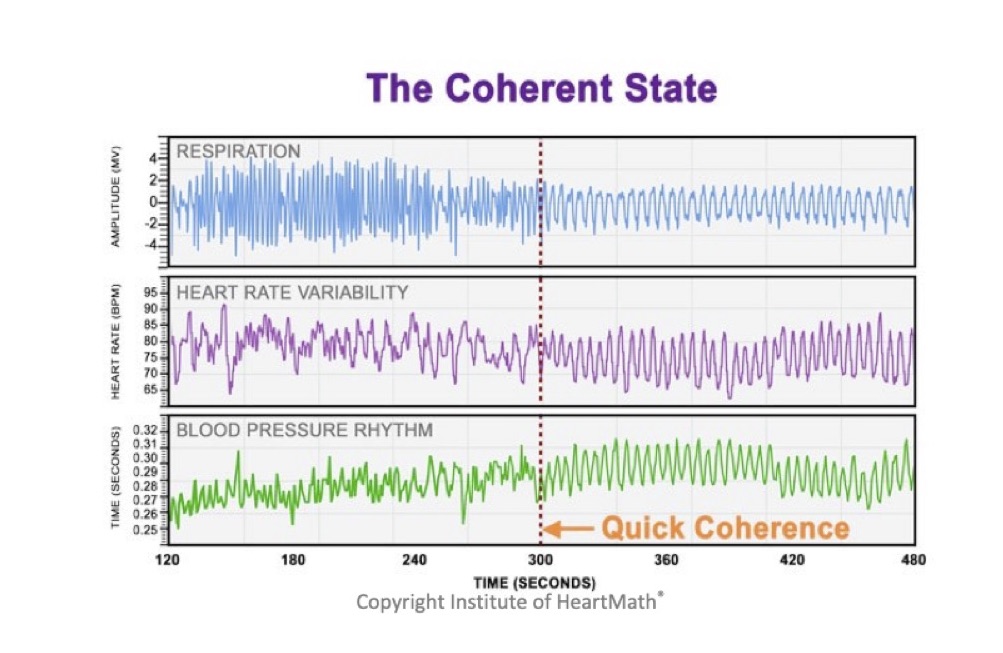
An air of mystery surrounds ‘The Zone’, a near mythical state of mind-body alignment which athletes seek but few master. Rupert Sheldrake (author and biologist) suggests that sport may be one of the few remaining ways for people to experience an altered state of consciousness. Sport requires: total concentration on the ‘present’; dedication; discipline and a will to explore and stretch beyond normal physical and mental capabilities. These qualities are all elements of committed spiritual practice potentially leading to similar experiences.
HeartMath® research suggests that this flow state is about heart-brain synchronisation achieved by connection with your intuitive heart. When we do this over and over, with intention, it gradually becomes easier. We begin to understand it’s not a one-shot experience but a place we can train ourselves to enter at will. There is a formula to get there to become physically, mentally and emotionally coherent. When we are coherent we are present, we think clearly, react intuitively and can play great sports.
The biofeedback from HeartMath® technology helps to build awareness of how our different emotional states affect the rhythmic pattern of heart activity. It gives real time information on your heart rate variability (HRV) which is a measurement of the time intervals between consecutive heartbeats.
Physically active individuals tend to have a higher HRV and this is associated with better health status. Athletes (recreational and professional) with a high HRV can respond, flex and adapt to the demands of their training and sport more easily. But like most things in life it’s about balance and sport has a positive and negative relationship with HRV. Your heart-beat is affected by your respiratory/cardiac cycle known as respiratory sinus arrhythmia or RSA. The sympathetic nervous system (fight or flight) is activated to cope with the demands of sport or exercise. If this exceeds available resources then vagus nerve function will diminish, negatively affecting our RSA and HRV.
Teaching people to sustain positive emotions facilitates emotional and psychological coherence, enhancing mind-body co-ordination and shortening reaction time. Tiger Woods was once asked during a championship game if there was a specific area players should look out for. His response “No, not really. I think the guys who are really controlling their emotions are going to win”. I remember some years ago watching my son play football and thinking how much time and energy the players were wasting on emotions like frustration and anger at referee’s decisions or missed goals. At the height of competition the ability to manage emotional reactions, make clear decisions and trust your intuition is often the difference between winning and losing.
Studies have shown that coherence can spread through entrainment, so team chemistry may result from a kind of collective team coherence or resonance. Perhaps a shared sense of energy, rhythm and intuitive knowing occurs to generate interaction and a successful team outcome. High school teacher and basketball coach Beth McHamee included HeartMath® techniques in their training. Before each game the team did a Heart Lock -in® and they used Quick coherence® on court and at half time. They ended the season with a record 15 wins compared to the previous six.
In Sweden hockey players trained in HeartMath® have used the techniques to switch from a chaotic to coherent emotional state when they are in the box watching the game. This has improved their game observation ability but in addition they improved their physical stamina. Master Kelly (World Martial Arts Champion) also found benefits outside of his sport. He used
HeartMath® techniques to maintain his edge to fight whilst competing in a younger competition category. He also used them to relax and handle stress from competition and travelling as well as to overcome injury setbacks and spark creativity and focus when writing his book.
HRV training and biofeedback have also been shown to play a useful role in the psychological response to injury and the rehabilitation process. The techniques can help them to deal with their roller coaster of emotions and the inevitable pain catastrophising which can become predictive. Compared to controls the HRV trained subjects lowered their respiration rates and improved on all psychological outcomes. Their perceived level of control increased with the opportunity to become an active participant in their treatment.
Get in touch to learn how to use the Heartmath® biofeedback technology and techniques to tackle those situations where you react emotionally rather than respond intelligently.
Experience science-based technology and coaching for taking charge of your life.
Proven to help you reduce stress and anxiety by increasing your inner balance and self-security.
Learn to access your heart’s intuition to become the best version of yourself more often.
“The brain thinks, but the heart knows” Joe Dispenza (neuroscientist)
Helen Maxwell
HeartMath® certified coach
www.helenmaxwellnutrition.co.uk
Helen@helenmaxwellnutrition.co.uk
REFS
Perry, J., et al. (2018) Effectiveness of athletes’ mental strategies in maintaining high heart rate variability: Utility of a brief athlete-specific stress assessment protocol, ‘Journal of Clinical Sport Psychology’, DOI: https://doi.org/10.1123/jcsp.2017-0016
Ravi, S., et al. (2018) Heart rate variability: biofeedback and controlled breathing, competitive and recreation sport athletes, 2nd International conference on lifelong education and leadership for all, Latvian Academy of Sport Education, pp.413-418.
Rollo, S., et al. (2017) Effects of a heart rate variability biofeedback intervention on athletes psychological responses following injury: A pilot study; International Journal of Sports and Exercise Medicine, 3(6) DOI: 10.23937/2469-5718/1510081.
Sheldrake, R., (2019), Ways to go beyond and why they work: 7 spiritual practices for a scientific age, Hodder and Stoughton Ltd.




